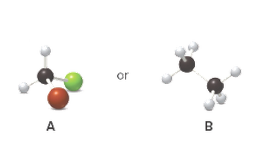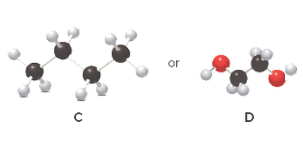
General, Organic, and Biological Chemistry - 4th edition
4th Edition
ISBN: 9781259883989
Author: by Janice Smith
Publisher: McGraw-Hill Education
expand_more
expand_more
format_list_bulleted
Question
Chapter 7.7, Problem 7.11P
Interpretation Introduction
(a)
Interpretation:
The compound having higher melting point from the given option should be predicted.

Concept Introduction:
The melting point is defined as a temperature required to convert a solid
Interpretation Introduction
(b)
Interpretation:
The compound having higher melting point from the given option should be predicted.

Concept Introduction:
The temperature at which a substance present in solid state starts converting into liquid form (i.e. starts melting) is termed as melting point.
Expert Solution & Answer
Trending nowThis is a popular solution!

Students have asked these similar questions
43) 10.00 ml of vinegar (active ingredient is acetic acid) is titrated to the endpoint
using 19.32 ml of 0.250 M sodium hydroxide. What is the molarity of acetic acid
in the vinegar? YOU MUST SHOW YOUR WORK.
NOTE: MA x VA = MB x VB
424 Repon Sheet Rates of Chemical Reactions : Rate and Order of 1,0, Deception
B. Effect of Temperature
BATH TEMPERATURE
35'c
Yol of Oh
نام
Time
485
Buret rend
ing(n)
12
194
16.
6
18
20
10
22
24
14
115 95
14738
2158235
8:26 CMS
40148
Total volume of 0, collected
Barometric pressure 770-572
ml
mm Hg
Vapor pressure of water at bath temperature (see Appendix L) 42.2
Slope
Compared with the rate found for solution 1, there is
Using the ideal gas law, calculate the moles of O; collected
(show calculations)
times faster
10
Based on the moles of O, evolved, calculate the molar concentration of the original 3% 1,0, solution (sho
calculations)
Steps and explanation please
Chapter 7 Solutions
General, Organic, and Biological Chemistry - 4th edition
Ch. 7.1 - Prob. 7.1PCh. 7.2 - Convert each pressure unit to the indicated unit....Ch. 7.3 - Prob. 7.2PPCh. 7.3 - Prob. 7.2PCh. 7.3 - Prob. 7.3PPCh. 7.3 - Prob. 7.3PCh. 7.3 - Prob. 7.4PPCh. 7.3 - Prob. 7.4PCh. 7.3 - The pressure inside a 1.0-L balloon at 25C was 750...Ch. 7.4 - A sample of nitrogen gas contains 5.0 mol in a...
Ch. 7.4 - Prob. 7.7PPCh. 7.4 - Prob. 7.5PCh. 7.5 - Prob. 7.8PPCh. 7.5 - Prob. 7.6PCh. 7.6 - CO2 was added to a cylinder containing 2.5 atm of...Ch. 7.6 - Prob. 7.10PPCh. 7.6 - Prob. 7.7PCh. 7.7 - Prob. 7.8PCh. 7.7 - Prob. 7.9PCh. 7.7 - Prob. 7.11PPCh. 7.7 - Which species in each pair has stronger...Ch. 7.7 - Prob. 7.12PPCh. 7.7 - Prob. 7.11PCh. 7.8 - Prob. 7.13PPCh. 7.8 - Would you predict the surface tension of gasoline,...Ch. 7.9 - Prob. 7.13PCh. 7.10 - Prob. 7.14PPCh. 7.10 - The human body is composed of about 70% water. How...Ch. 7.10 - How much energy is required to heat 28.0 g of iron...Ch. 7.10 - Prob. 7.15PCh. 7.10 - Prob. 7.16PPCh. 7.10 - If the initial temperature of 120. g of ethanol is...Ch. 7.11 - Use the heat of fusion of water from Sample...Ch. 7.11 - Answer the following questions about water, which...Ch. 7.11 - Prob. 7.19PPCh. 7.12 - Answer the following questions about the graph...Ch. 7.12 - How much energy (in calories) is released when...Ch. 7.12 - How much energy (in calories) is required to melt...Ch. 7 - Prob. 19PCh. 7 - Prob. 20PCh. 7 - Prob. 21PCh. 7 - The compressed air tank of a scuba diver reads...Ch. 7 - Assume that each of the following samples is at...Ch. 7 - Use the diagrams in problem 7.23 to answer the...Ch. 7 - Prob. 25PCh. 7 - Prob. 26PCh. 7 - Prob. 27PCh. 7 - Prob. 28PCh. 7 - Prob. 29PCh. 7 - Prob. 30PCh. 7 - Prob. 31PCh. 7 - Prob. 32PCh. 7 - Prob. 33PCh. 7 - If you pack a bag of potato chips for a snack on a...Ch. 7 - Prob. 35PCh. 7 - Prob. 36PCh. 7 - Prob. 37PCh. 7 - Prob. 38PCh. 7 - Prob. 39PCh. 7 - Prob. 40PCh. 7 - Prob. 41PCh. 7 - Prob. 42PCh. 7 - Prob. 43PCh. 7 - Prob. 44PCh. 7 - Prob. 45PCh. 7 - Prob. 46PCh. 7 - Prob. 47PCh. 7 - Consider balloons A and B, which contain CH4 and...Ch. 7 - Prob. 49PCh. 7 - Prob. 50PCh. 7 - Prob. 51PCh. 7 - Prob. 52PCh. 7 - Prob. 53PCh. 7 - Prob. 54PCh. 7 - Prob. 55PCh. 7 - Prob. 56PCh. 7 - Prob. 57PCh. 7 - Prob. 58PCh. 7 - Prob. 59PCh. 7 - Prob. 60PCh. 7 - Prob. 61PCh. 7 - Prob. 62PCh. 7 - Prob. 63PCh. 7 - Prob. 64PCh. 7 - Which molecules are capable of intermolecular...Ch. 7 - Prob. 66PCh. 7 - Prob. 67PCh. 7 - Explain why the boiling point of A is higher than...Ch. 7 - Prob. 69PCh. 7 - Prob. 70PCh. 7 - Prob. 71PCh. 7 - Prob. 72PCh. 7 - Prob. 73PCh. 7 - Prob. 74PCh. 7 - Prob. 75PCh. 7 - Prob. 76PCh. 7 - Prob. 77PCh. 7 - Prob. 78PCh. 7 - Prob. 79PCh. 7 - Prob. 80PCh. 7 - Prob. 81PCh. 7 - How many calories of heat are needed to increase...Ch. 7 - Prob. 83PCh. 7 - If it takes 37.0 cal of heat to raise the...Ch. 7 - Prob. 85PCh. 7 - What phase change is shown in the accompanying...Ch. 7 - Prob. 87PCh. 7 - Which process requires more energy, melting 250 g...Ch. 7 - Consider the cooling curve drawn below a. Which...Ch. 7 - Prob. 90PCh. 7 - Draw the heating curve that is observed when...Ch. 7 - Prob. 92PCh. 7 - Use the following values to answer each part. The...Ch. 7 - Prob. 94PCh. 7 - Prob. 95PCh. 7 - Prob. 96PCh. 7 - Prob. 97PCh. 7 - Explain why you feel cool when you get out of a...Ch. 7 - Prob. 99CPCh. 7 - As we learned in Chapter 5, an automobile airbag...
Knowledge Booster
Similar questions
- Use diagram to answer the following: 1.Is the overall rxn endo- or exothermic. Explain briefly your answer____________________2. How many steps in this mechanism?_____________3. Which is the rate determining step? Explain briefly your answer____________________4. Identify (circle and label) the reactants,the products and intermediate (Is a Cation, Anion, or a Radical?) Please explain and provide full understanding.arrow_forwardDraw the entire mechanism and add Curved Arrows to show clearly how electrons areredistributed in the process. Please explain and provide steps clearly.arrow_forward15) Create Lewis structure Br Brarrow_forward
- LIOT S How would you make 200. mL of a 0.5 M solution of CuSO4 5H2O from solid copper (II) sulfate? View Rubricarrow_forwardSteps and explantions pleasearrow_forwardMatch the denticity to the ligand. Water monodentate ✓ C₂O2 bidentate H₂NCH₂NHCH2NH2 bidentate x EDTA hexadentate Question 12 Partially correct Mark 2 out of 2 Flag question Provide the required information for the coordination compound shown below: Na NC-Ag-CN] Number of ligands: 20 Coordination number: 2✔ Geometry: linear Oxidation state of transition metal ion: +3 x in 12 correct out of 2 question Provide the required information for the coordination compound shown below. Na NC-Ag-CN] Number of ligands: 20 Coordination number: 2 Geometry: linear 0 Oxidation state of transition metal ion: +3Xarrow_forward
- Can you explain step by step behind what the synthetic strategy would be?arrow_forwardPlease explain step by step in detail the reasoning behind this problem/approach/and answer. thank you!arrow_forward2. Predict the product(s) that forms and explain why it forms. Assume that any necessary catalytic acid is present. .OH HO H₂N OHarrow_forward
arrow_back_ios
SEE MORE QUESTIONS
arrow_forward_ios
Recommended textbooks for you
- Chemistry: Matter and ChangeChemistryISBN:9780078746376Author:Dinah Zike, Laurel Dingrando, Nicholas Hainen, Cheryl WistromPublisher:Glencoe/McGraw-Hill School Pub Co
 Chemistry for Today: General, Organic, and Bioche...ChemistryISBN:9781305960060Author:Spencer L. Seager, Michael R. Slabaugh, Maren S. HansenPublisher:Cengage Learning
Chemistry for Today: General, Organic, and Bioche...ChemistryISBN:9781305960060Author:Spencer L. Seager, Michael R. Slabaugh, Maren S. HansenPublisher:Cengage Learning

Chemistry: Matter and Change
Chemistry
ISBN:9780078746376
Author:Dinah Zike, Laurel Dingrando, Nicholas Hainen, Cheryl Wistrom
Publisher:Glencoe/McGraw-Hill School Pub Co

Chemistry for Today: General, Organic, and Bioche...
Chemistry
ISBN:9781305960060
Author:Spencer L. Seager, Michael R. Slabaugh, Maren S. Hansen
Publisher:Cengage Learning